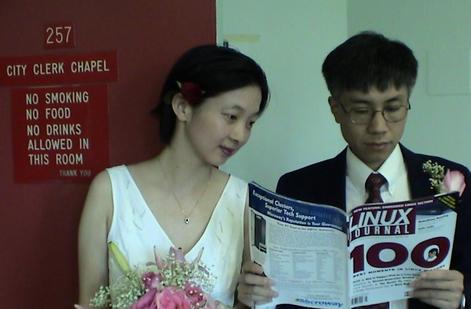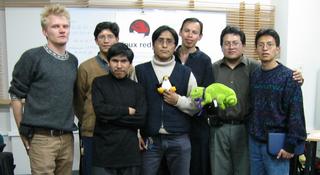
This photo was taken when my wife and I were waiting to get married in the chapel on the second floor of New York City Hall. I just received the 100th issue of LJ and brought it along. You can tell from the photo that my wife was a little jealous. So the title for the photo is “Beauty or LJ”. Hope you like it.
—Ning Qian

Beauty or LJ: Bride-to-be Qing Xiang peeks at fiancé Ning Qian's Linux Journal (photo: Nicole Xiang).
I enjoyed reading your article about setting up an FTP proxy [LJ, December 2002]. I was just curious about one point. You make a comment about not being able to configure the acceptable commands list differently for internal and external users. Is it possible to set up two proxies then route the incoming requests at the firewall for internal addresses to one proxy and those from external addresses to the other?
—John
Mick Bauer replies: That's an excellent idea! You could set up a proxy on the firewall for external users, with read-only permissions, and set up a proxy on some host on the inside for outbound transactions, with looser permissions. You could then configure your firewall to permit outbound FTP only if it originates from the designated internal proxy.
It's great to see those huge old machines coming back! I saw an advert in Linux Journal for a CDC 6400, the baby brother of the immense CDC 6600. Of course today we could not use Freon to cool it. And software is coming back! SOAP, for instance, the Symbolic Optimal Assembly Program for the IBM 650. Magnetic drum memory will never die! I have even seen articles about ASP, the Attached Support Processor for the IBM 360/65. Who says I'm a dinosaur?
—Peter Chase, Alpine, Texas
The articles on ptrace in the November and December 2002 issues were very informative. So what's to stop someone from using ptrace to insert some malevolent code in a running program? Forgive me for looking on the dark side.
—Walter S. Heath, Concord, Massachusetts
Keep thinking evil thoughts. You can't keep a system secure without studying possible attacks. Fortunately, you can only ptrace a process if it's your own process, or if you're root.
—Editor
I have found an error in my article, “OpenLDAP Everywhere” [LJ, December 2002]. In the auto.home section on page 54, the gomerp entry has the line:
cn: super3
The line should read:
cn: gomerpA reader contacted me after copying the entry exactly from the article. He has fixed his configuration and is up and running with unified logon. Matt Lung and I are very pleased with the article as published. Our mothers are very proud!
—Craig Swanson
We were a little disappointed by your article on the applications for the Zaurus. You listed many commercial applications and yet when it came to mapping/navigation software you listed only the free one. zNav and zNav Lite are the only Zaurus mapping/navigation products that use commercial navigation charts.
—Patrick Cannon, Barco Software, LLC
Here the world's highest Linux install event took place Saturday the 12th of December 2002, 11,000 feet above the sea. It was the first of its kind in this part of Bolivia—and maybe a world record when it comes to altitudes and Linux install events.

The organizers task force: Janus Sandsgaard, Edgar Ruiz, Juan Conorel, Devin Conde, Hardy Beltran, Christian Mollo and Jorge Castro.
—Janus Sandsgaard
Yesterday I was very happy to see that the Zaurus was on the cover of the January 2003 issue of LJ. I am involved in the OpenZaurus Project, and I would really appreciate a monthly section on the Zaurus on LJ.
—Paolo
When you mention the Zaurus applications tkcGallery and MooView [LJ, January 2003], you completely leave out the point that MooView cannot handle even reasonably sized files, just like the included image viewer, while tkcGallery can handle virtually any size image. I've tested up to ten megapixels so far. The general feeling here is that if it is a commercial app you must make some negative mention, and if it is free then there must be nothing wrong with it.
—Shawn Gordon, President, theKompany.com
Guylhem P. Aznar responds: I just could not recommend every single application. Yes, I did mention the problems I had and the existing free software equivalent if there were any, but I also gave strong purchase advice for some unique software such as tkcJabber.
Go to a Borders bookstore some Saturday as I do and pick up a book on Linux, or Linux Journal, and read it. Stay there for two hours and you will have a minimum of two people come up to you and tell you of their companies' recent conversion from Windows to Linux servers.
—Charles Ebert
Hey! This isn't a library! Are you going to buy that?
—Editor
Somehow I managed to forget to bring reading material for my Thanksgiving flight, so I found myself looking through the junk that the airports had to offer. My brother said I should get a magazine but I refused to pay five bucks for something without content. I returned home to my latest Linux Journal. In every issue you folks manage to cram lots of good stuff onto those pages. So many computer magazines are more like bridal zines, to be purchased only when one is in the market for something new. Linux Journal, on the other hand, puts together great articles for people who actually use the machines they own. So I just wanted to send out a thanks. Some days I think your organization is the only place that has a clue as to what people want.
—Tim
I have to disagree with the comments made by Tom Amon in your January 2003 Letters section (entitled “Red Hat 8.0: Love the License, Hate the Look”). Red Hat has made an attempt to bring forward a “best of breed” desktop. Having KDE (or GNOME if you wish) pre-setup with Mozilla, Evolution and OpenOffice seemed, to me, a vast improvement over the 7.3 release. I'll concur with Tom that the result is not perfect (where did Xine go, Red Hat?), but this is a road I would like Red Hat to stay on.
—Timothy J Halloran, Carnegie Mellon University
An excellent article on how to use your Zaurus and what various hardware and software options are available [LJ, January 2003]. The Zaurus is a system that can stand on its own, and more articles on it would be welcome. I can also say that I find the advertising in your magazine an excellent resource of what's available in the Linux world.
—Julian Macassey
The author of “Compiling Java with GCJ” [LJ, January 2003] misses the point of what makes Java a more viable solution than any natively compiled language, namely, platform neutrality á la the Virtual Machine. Simply put, natively compiling Java defeats the primary purpose of why Java was invented in the first place. I compile GIS Java code once on Linux and run that same code on Mac OS X, AIX, Solaris and more, with great success and eye-popping performance. A key Java goal is to limit the long development cycle time of software by avoiding native porting overhead.
—Bryan McKinley
On page 15 of the January 2003 Linux Journal you have a full-page ad from Rackspace. I would advise anybody looking for hosting NOT to go to Rackspace. They are well known for hosting spammers. The “100% network uptime” they boast about in the ad does you no good if your class C is blackholed due to the spammers you share it with. I would advise anybody seeking hosting to closely check the anti-spamming resources before contracting for hosting.
—David D. Hagood
Likewise, you should check out any spam-filtering service you plan to use to see how much legitimate mail gets blocked because of who the sender's network neighbors are. The www.linuxjournal.com web site is at Rackspace, and it works fine for us.
—Editor
I enjoyed both Renato Carrara's letter in the December 2002 Linux Journal, and Gary Nickerson's reply in the January 2003 issue. I don't think that it's necessarily dangerous for a (relatively) small-circulation publication like Linux Journal to sell advertising to Microsoft; Bill's money is just as green as anyone else's. However, as a publication grows, it needs to beware of developing a dependency on large, powerful advertisers such as Microsoft. High overhead can make them susceptible to the threat (explicit or unstated) of one or more large advertisers pulling their ads. I hope that LJ can grow at a measured pace and thus maintain its independent spirit and its outstanding content. In the meantime, I appreciate your great work in building a very useful and readable publication. Please keep it up. And, hey, if you're able to siphon off a few bucks from The Beast along the way, more power to ya.
—Ken
Regarding the letter “An Ad Is an Ad” in the January 2003 issue, I think the decision not to run ads from Microsoft is a great one. If I need information from them I know exactly where to find it. The ads in Linux Journal nowadays are really a welcomed break from other “infested” publications. I think it's really important that you guys keep your focus on the values of where you came from, since it really makes a big difference for us readers. Truly, it's a joy to read your magazine, all the fresh people and talk and the lack of all the corporate bull.
—Boris Debic, San Mateo, California